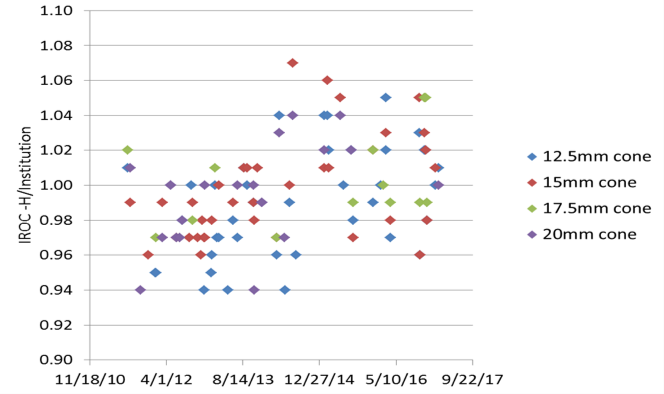The IROC-H QA Center is funded to provide radiation oncology core support and quality audit programs for the National Cancer Institute's (NCI's) clinical trials. These programs include an independent peer review of dosimetry practices at participating institutions. Since 2007, IROC-H has been making small field dosimetry measurements (down to a field size of 2 x 2 cm2) to verify each institution's ability to measure and model small field output factors in their treatment planning systems (TPS) during onsite visits. These measurements were compiled to generate a standard data set which was published back in 2012.1,2 The standard data values allow an institution to perform treatment planning system (TPS) calculations under the same conditions the standard data measurements were made and then perform their own comparison as a redundant verification of their TPS's commissioning for small field dosimetry. The 2012 publication provides guidance for parameters to examine to improve TPS and measurement agreement for Pinnacle, and also refers the reader to an additional publication that gives guidance for Eclipse users.3 Such efforts are important for physicists to undertake because even for such relatively large fields such as 2 x 2 or 3 x 3 cm2, errors are very common: 59% of institutions assessed by IROC-H has at least one output factor that disagreed by 3% or more with their TPS calculated value.4
The IAEA has also conducted many Coordinated Research Projects (CRPs) that have identified remote QA audit tools that Low and Middle Income Countries (LMIC) can use to perform peer reviews of their radiation therapy institutions. These projects range from simple output checks under reference conditions to more complex capabilities such as MLC performance, heterogeneity correction verifications and small field dosimetry. One of these developed IAEA audits is the use of IROC-H's standard small field dosimetry data. The multinational results of this specific audit have been accepted for publication5 and show the need for identifying and assistance with correcting small field dosimetry discrepancies. On a national level, the IAEA's audit revealed that many of the small field output factors analyzed were outside of a generous 3% criterion.
The Medical Physics community worldwide has realized that what we were doing in the past for small field dosimetry measurements was often wrong, even for relatively large 2 x 2 cm2 fields. For even smaller fields the challenges are often greater; ion chambers are too big and need volume averaging corrections, and even very small detectors such as diodes required specific output correction factors that can be substantial. Through many publications, presentations and most recently the IAEA/AAPM Technical Report Series No. 483 "Dosimetry of Small Static Fields Used in External Beam Radiotherapy", an international Code of Practice for Reference and Relative Dose Determination6, medical physicists are making and implementing the required small field dosimetry corrections. As seen in Figure 1, there seems to be a shift in of IROC-H's remote single small field output audit results that occurred towards the end of 2013 after the implementation of new published correction factors. IROC-H encourages all medical physicists to read the IAEA/AAPM report 483 and make the appropriate changes to their small field dosimetry practice.
 Figure 1. IROC-H single small filed remote audit results from 2010 to 2017.
Figure 1. IROC-H single small filed remote audit results from 2010 to 2017.
We have noticed that you have an ad blocker enabled which restricts ads served on this site.
Please disable it to continue reading AAPM Newsletter